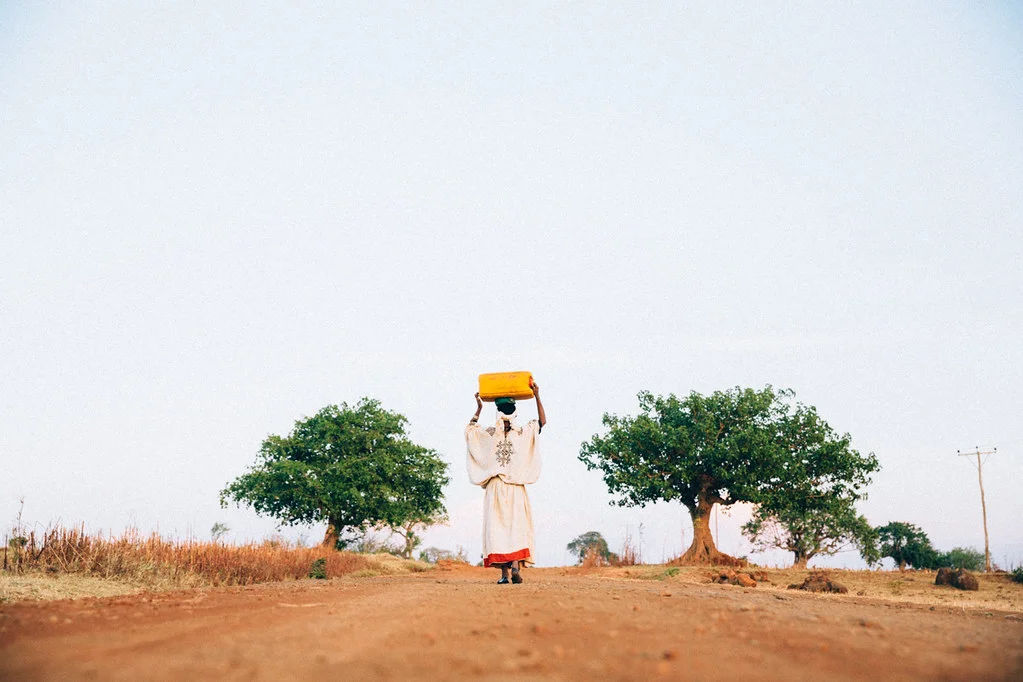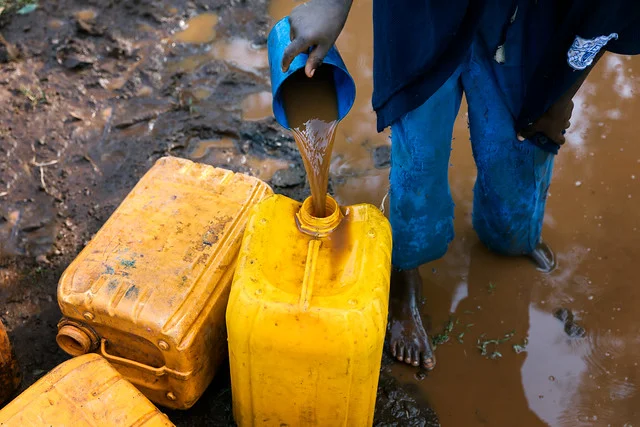It was a humid, cloudy day in July. Driving along the wet clay roads of southern Ethiopia I found myself immersed in the reality of my work. I paid no attention to the bumpy roads, chaotic with wagons and vehicles and livestock. Nor did I take time to photograph the lush, green hills that rolled across the distance. Rather, with each passing kilometer, I couldn’t ignore the yellow jerry can after yellow jerry can I saw carried by women, girls, and boys as they walked alongside the traffic. Some carried two at a time, one in each hand, while others hoisted the up-to-forty-pound plastic containers onto their heads, balancing the weight with each step.
Given my six years of work at Water.org, I am well-versed in the enormity of the global water crisis. Until this moment, watching women who still lack access to safe water carry the heavy, yellow containers, I had yet to associate the color with anything so dark as the reality of the water crisis here.

Today, 61 million Ethiopians lack access to safe water and 65 million lack access to improved sanitation. In rural Ethiopia, a Water.org survey found that many women and their children walk more than three hours to collect water, often from shallow wells or unprotected ponds they share with animals. And despite living in poverty, a percentage of these 61 million pay for their water. It can cost them up to 20% of their overall income, and motivated by survival, they pay it.
Most moms will do whatever it takes to keep those we love most, alive. And for these women, it’s walking long-distances carrying yellow jerry cans. It is paying a fifth of their income to get water. If I had no water to give my daughter, I would do what I saw the moms in Ethiopia doing. Because I have it at home, I do what I do at Water.org to help change those women’s lives.
At Water.org, we work every day to break down the barriers standing between families and access to safe water and sanitation. Of the 844 million people in the world who lack access to safe water, hundreds of millions of them could pay for their own solution over time, if given the opportunity. In a 2014 survey of more than 400 rural households in Ethiopia, we found 70% of respondents were interested in a loan for improved water and 64% of respondents were interested in a loan to meet their sanitation needs. Five years later, we are making progress in the country satisfying the demand and changing lives. By making small, affordable loans possible, Water.org has reached 219,000 people in Ethiopia with safe water and sanitation connections at home.
By the time I arrived at my destination on that July afternoon, the color yellow took on a familiar tone. Surrounded by lily-like, golden flowers, the village I was to work in seemed peaceful. Fewer jerry cans in sight, I knew our solutions were working. As I exited my vehicle, Butukan greeted me. I couldn’t help but notice she was wearing a yellow sweater. Butukan and her husband Matthews built their mud and thatch home a couple of years ago, before their daughter was born. Once the house was built, Matthews checked off his young family’s need for shelter however, he knew they still needed access to water at home. “But how?” was Matthew’s question. He and Butukan were just starting a family. They explained that to pay for a water connection and tap all at once wasn’t possible, it was out of their budget. So they continued life as it was - he herded sheep to sell, Butukan collected water.

The water she collected was from a kiosk about a mile from their house. It cost a little more than one cent per liter. It added up quickly for Matthews and Butukan as they required gallons of water for drinking, bathing, laundry, cooking and cleaning.
Matthews learned about a way to change their future through his local bank. In partnership with Water.org, Matthews’ bank offers small, affordable loans for water connections and toilets. The amount Matthews and Butukan paid for water at the kiosk far exceeded the payments toward a lasting water solution in their home. Matthews decided financing a water connection was the answer to his question. With their baby’s arrival fast-approaching, Matthews and Butukan used the loan to connect to their local water line, bringing water home.
With a smile, Butukan shared, “Now I can keep our home and our baby clean. I can water our garden and grow banana trees to sell the fruit. I even sell water to some of my neighbors. Most of all, I am free from the daily labor of carrying water.” I smiled back at Butukan, standing there in her yellow sweater holding her daughter, she was everything I believe yellow to be - optimistic, hopeful, bright.
Join us as we work toward the day women and children can shelve their yellow jerry cans because, like Butukan, they too have access to safe water at home.
Melanie Mendrys is the director of brand and marketing at Water.org.